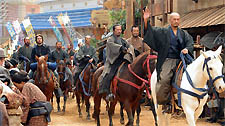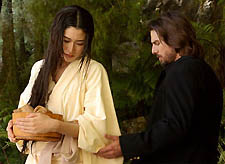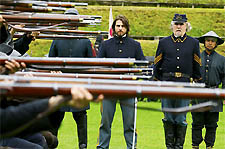Battle Fatigue
The Last Samurai
You’ve gotta hand it to Edward Zwick — when creating an historical war epic, he’s got the formula down pat: Make it bigger than life, but attach a human story to ensure that oh-so-vital emotional connection. And if you’ve got a powerhouse star at your disposal, all the better. It’s an ages-old formula — one refined by such filmmakers as David Lean and Akira Kurosawa. And the funny thing is, it still works. Though not, perhaps, like a charm.
Zwick’s The Last Samurai is without question the biggest film he’s ever made — bigger than Glory, bigger than Legends of the Fall, it’s packed with details and huge outsized moments, both on the battlefield and off. And yet for all its perfectly-cued intensity and its core story of personal redemption, the movie is a hollow experience.
Tom Cruise plays Captain Nathan Algren, a Civil War hero haunted by his participation in a raid on an Indian village, in which defenseless women and children were brutally slaughtered. He’s descended into a pit of bitter, alcoholic-fueled self-loathing. The path to ultimate salvation comes in the form of a job, as Algren is hired by his country to travel to Japan and train peasants in the way of the gun in an effort to quash a Samurai rebellion against the Emperor.
 |
Wounded in an initial battle with the sword-wielding Samurai, Algren is taken prisoner and spends the winter in their village. The Samurai leader — the wise, thoughtful, and sometimes playful Katsumoto (Ken Watanabe) — sees in Algren a kindred spirit. “I want to get to know my enemy, ” he says, and forbids the more hotheaded amongst his warriors to cut off the American’s head and thereby bring an end to the story.
During his captivity, Algren learns that these so-called “savages ” are in fact the most disciplined people he’s ever met, a people “dedicated to perfection. ” As he and Katsumoto embark on one philosophical discussion after another, he learns to speak Japanese. And, while serving as a replacement father-figure for the two young boys whose father’s life he took in battle, he learns how to love himself and, well gosh darn it, to laugh again.
 |
The boys’ mother and Katsumoto’s sister, Taka, incidentally, is hardly ecstatic with having her husband’s murderer in her house. But she politely demurs to her imposing brother. This being an epic, we need a romantic hook and Taka provides it — eventually thawing and falling in love with the scraggly-bearded, wool-sock-wearing American.
Algren is ultimately forced to make a choice between the Samurai and his own country, which during his captivity has seen fit to supply the Emperor’s incompetent army with a supply of shiny new Gatling guns. That’s fighting with honor.
In the final battle — a spectacularly violent flurry of modern guns and bayonets pitted against traditional arrows and Samurai swords — our boy Algren regains his honor and realizes his destiny.
|
The Last Samurai wears its theme of tradition versus modernization on its kimono sleeve. There’s little subtext here and the movie has enough historical inaccuracies to keep Japan history buffs abuzz for hours. But Zwick isn’t out to tell a straightforward history lesson — he’s out to provide big swordplay with a bold emotional upsweep, in the process creating in Algren a mythic character, a warrior redeemed by the purity of the sword. Or, I’m sure Zwick is hoping, The Oscar.
Zwick directs with grace and clarity, and yet the film never sits quite right. Part of the problem is Tom Cruise, who, despite an attempt at a subtle performance that includes an unkempt Civil War era-style beard, can’t truly conceal his stardom. Cruise isn’t a strong enough actor to vanish into the role — his contemporary appeal burns through the historical veneer like a laser, yanking it into the present. Still, he has the kind of mega-starpower to drive audiences to the film in droves.
Cruise is balanced by Watanabe, who plays Katsumoto with a fine blend of serenity and intensity. Masato Harada is compelling as the Emperor’s self-serving advisor, and Timothy Spall, as a British translator, lends surprising depth to an otherwise one-note role. But Tony Goldwyn, gaunt and goateed, gives a devastatingly bad performance as Algren’s nasty commanding officer.
 |
The battle scenes are vivid, with swords and arrows piercing virtually every exposed body part. The Samurai’s horses tumble with a balletic eloquence, captured in glorious slow motion by cinematographer John Toll. Watching the final onslaught, you can’t help but be impressed by the amount of stunt horses still available to Hollywood directors.
The Last Samurai‘s two and a half hours pass almost effortlessly. But it simply doesn’t do much in the way of moving your soul or rousting your spirit, much in the same way that the recent seafaring adventure Master and Commander manages to. You leave the theatre not feeling transformed or enlightened, but rather more than a little battle fatigued.
Support Metro Weekly’s Journalism
These are challenging times for news organizations. And yet it’s crucial we stay active and provide vital resources and information to both our local readers and the world. So won’t you please take a moment and consider supporting Metro Weekly with a membership? For as little as $5 a month, you can help ensure Metro Weekly magazine and MetroWeekly.com remain free, viable resources as we provide the best, most diverse, culturally-resonant LGBTQ coverage in both the D.C. region and around the world. Memberships come with exclusive perks and discounts, your own personal digital delivery of each week’s magazine (and an archive), access to our Member's Lounge when it launches this fall, and exclusive members-only items like Metro Weekly Membership Mugs and Tote Bags! Check out all our membership levels here and please join us today!























